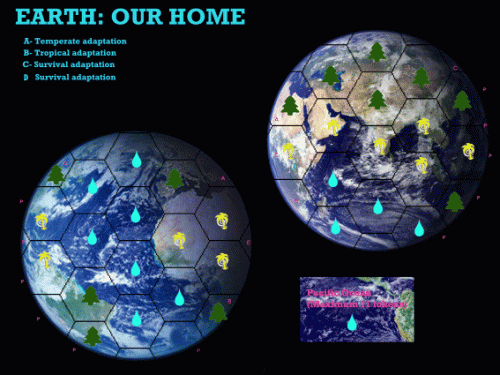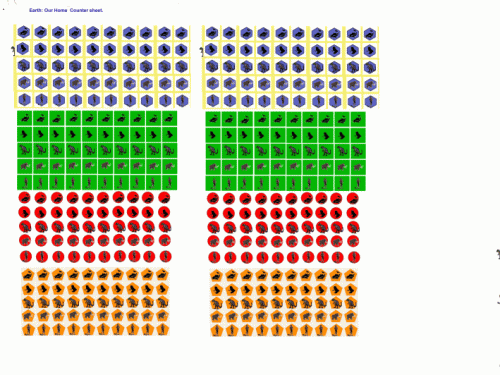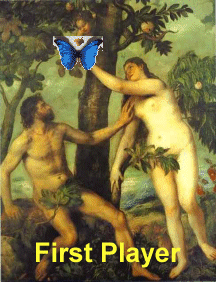Welcome to Earth: Our Home -- The Board Game!
For 2-4 players, ages 8+
For the contest this month I decided to do something a bit different, and so I have designed a board game. If you are brave enough you can print it out and play it, and if you do please tell me how it went! Feel free to modify or improve it as you see fit.
You can now download the components at (including much smaller and easier to print versions - read the text file first!)
http://rapidshare.com/files/354314137/E ... r_Home.zip
You can see the board, counters and some of the cards here on this article, but if you want to print and play the game, and I really hope you will, then you will find it easier to download the printer friendly zip files and print the files in there which are configured for A4 card or paper.
What’s it about?
The game covers the development of life on Earth from the Cambrian era – c.500 million years ago, with the last turn representing he arrival of the first hominids – Homo Erectus and friends – about 1 million years ago. Even the most fanatical board game player will be pleased to hear that each turn is not a million years! Instead of 500 turns, game play is divided in to five EPOCHS – each epoch covering a lengthy period of Earth’s history.
So what do you do in it?
Well the problem with any game based on evolution is that the process is rather blind and to some extent random – and there is absolutely no guarantee that if we re-ran the tape of Earth’s history we would have human beings here now reading my writing, or indeed any recognisable species, or perhaps any life at all. So in this game we take the viewpoint in each epoch of a GENUS*, a set of beasties related to one another by descent, competing to adapt to and survive (and proliferate). Each turn you lay down 18 counters representing your current SPECIES on the map of the world, trying to control HABITATS. Of course its not just a matter of your species happily filling up these habitats. Other species probably want them too – each habitat can only support three counters (with one exception we will come to later). Given that other players are controlling the other species, and might well be fiercer, hungrier or just plain bigger than your species — well bad things will happen. If a habitat gets too popular, and hence overpopulated, bad things happen.
Only the species which is best adapted to life in that area is likely to survive, and many of your beasties will die: in the worst case some of your species may even go extinct, potentially removing you from the game, and certainly meaning you will have to explore other avenues of evolution. In fact given the constant struggle for resources, it may be that your species will have to kill off its relatives (from the same genus, but earlier epochs)just to find space to survive.
Survival of the Fittest
So how do your beasties take over habitats and make sure they don’t die out? By being better adapted to their habitats than their competitors, and that comes down to random luck to some extent – little bundles of chemical information called GENES. Each epoch your species gains new genes – and develops, becoming more effective at taking over territory. Unfortunately you don’t control what new abilities nature grants you – you just pick a gene card, and your new species counters get that added ability, as well as all the ones they have from their ancestors (your previous species).
As you add gene cards at random to your species however where they might prosper and the best strategy for which habitats to try an colonise will shift, causing you to make tough decisions. Not decisions about which genes you get – you can’t control that – but about how your beasties can make best use of the genetic heritage they have to prosper and survive.
Game Components
You will need a game board: this is best achieved by printing Earth 1, EArth2 and the Pacific zone files from the zip: the earth files are( 4 A4 posters so you will need to set your printer or reduce them in size again) If you are short on ink, printing 8 pages of A4 (or whatever) and taping them together strikes you as hell, or you otherwise can’t print the map, it’s fine to just draw it on a big bit of card or a wall, so long as you get ti to look roughly the same in terms of areas. Take a look at the board: you will notice it shows two views of planet Earth from space. Use the "small***counter files - you get all you need on one sheet of A4 for each colour).

The board for "Earth: Our Home" the game: the components to make it are included in the zip file, you will need it to play.
Part of the globe is not shown: it’s the Pacific Ocean, and mainly sea, so in this game it’s represented by the little rectangular box labelled “Pacific Ocean”! As you can see the board is divided in to hexagons, some complete, some partial, which represent HABITATS. Some partial ‘hexes’ are too small to be bothered putting counters on so we ignore them, but most of them have one of three symbols – a water drop for a MARINE habitat (the sea!), a palm tree for a TROPICAL habitat and a pine tree for a TEMPERATE habitat. Temperate and Tropical habitats are LAND: marine habitats are, unsurprisingly enough, SEA.
Now take a closer look at the board. Earth is a funny old place, so to handle movement some zones are marked with a letter. A and A, see two of them? B and B? C and C? D & D? The two bits marked with the same letter are the same habitat: all the rules apply as normal (no more than three beasties in each, and so forth). Living on a globe plays hell with inventing rules for “movement”. The Pacific is a huge area where 11 counters can peacefully co-exist – enter from any region marked with a P adjacent.

The counters for Earth: Our Home board game: download the zip file and use smalll***counters files get printer friendly ones at the right scale.
Next up you should see counters: 100 for each genus, divided in to 5 species representing something about the type of life forms involved. Don’t take them literally – your creature in epoch one lives in the sea, and may well be a fish, but not a modern one, and the frog on the epoch two counter just means your species then is an amphibian, and can go on land. Epoch Three shows an Allosaur, but you might be anything, and Epoch 4 is just a mammoth for the age of mammals – but maybe on ‘your earth’ the dinosaurs never died out, and really it’s a big lizard. Use your imagination, and describe what your species looks like to the other players. That last little man is a Homo Erectus by the way. Still maybe your final species look like super-intelligent jellyfish, or lizardmen, or big birds, or… anyway you get the picture, it’s just an illustration. Now you will need to print the counters off: you use 18 of each species on the map, one is a spare, and one you place on your genes cards – more of which later. Stick them on coins, mount them on card, whatever works for you. You play them to the board by piling them in the appropriate habitat.
Finally there are 32 gene cards. There are four types of gene card, distinguished by the letters A, B, C, & D (in reality we would have the letters A, C, G & T for adenine, cytosine, guanine, and thymine, but I was worried someone might take this too literally.) They are so important they get their own bit of the rules (see below).
GENE CARDS
At the beginning of each epoch comes the MUTATION PHASE. Random variations in offspring born have led to a development in your species: on turn one it will effect your little fishies. So shuffle the genes, and randomly deal each player a gene card, which they put face up in front of them with a spare counter of the current species on. So if it’s turn one, and you get an “A gene”, put the A card in front of you with your spare fish counter on it.
What do they do? Well an A card gives your beastie a +2 in SURVIVAL CONTESTS in temperate habitats, and represents some kind of adaptation (big teeth, camouflage, better brain, improved senses) which give it a big advantage in that type of habitat. A B card does exactly the same in Temperate climates. C & D cards do something similar – they reflect a new adaptation that works well in ANY environment, but if you happen to have the symbol in the corner, say you are playing blue square genus and you get the blue square C, well sheer random luck means it happens to be a very powerful adaptation, worth +2 in ay environment. (Really big teeth, or squirrelly reflexes – at first sign of danger you grab your nuts and run?) No having an A or B gene in Epoch One, when everyone is confined to Marine habitats is pretty useless.
However unlike in individuals today, genes can’t do you any harm: you are a species, only the members with good genes get to mate with the lady or gent beasties as much and have lots of little beasties, so no need to worry about poor genes.
Those fishy genes which only work on land areas (A or B cards) will come in to their own later, because when you take your new species, it draws new card, and adds that to the existing one. Any remaining members of the former species on the board don’t get the advantage of the new gene – only the latest species, but it gets both. So your Epoch 5 creatures will have the advantage of ALL 5 genes (assuming nothing terrible has happened along the way). So ok, they give you +1, or +2, in either certain habitats or anywhere.Why does this matter? Because you add up these bonuses to work out your species counters CONFLICT VALUE. A creature in a temperate environment with genes A, A, C (but no their symbol) gets 2 +2 +1 = 5. Their conflict value is 5. It's not about fighting: it's about how well adapted you are to your environment.

Gene cards: You need the A,D and B ones as well to play. Download from the zip file or message me for a copy - it's free
GO FORTH AND MULTIPLY
Firstly, if it’s not the first turn, choose one of your counters to mutate. Take it off the board, and replace it with a counter of your new species that has evolved out of the old one. In the first turn you just plonk your six counters down. Each turn after drawing your mutation each player plays counters to the board, representing their species going forth, multiplying, and slowly filling up habitats. In each turn someone is first player, and they MUST PLAY SIX COUNTERS (well five including the one that ‘evolved’ ) ONE AT A TIME to habitats adjacent to that species. You can put up to three counters in any one habitat, or spread out thinly, up to you, but each habitat you enter must be adjacent to, or the same as, a habitat you already have a counter of this species in.
Note species: if you are putting Mammoth counters down they must be adjacent to an existing Mammoth counter, not another older counter of your colour(they may be in the same habitat, and that’s fine, though) Once you have put six counters down, the player to you left plays six counters exactly the same way round their newly evolved species. .After there turn, the next player, and so on till it’s your turn again. You don’t start a new Epoch, you just play your second six counters, and when your turn comes round again your third six, so now hopefully (but not necessarily) you have 18 counters on the board.
In Epoch One your beasties must stay in the sea: In Epoch 2 they can go on sea or land, being amphibians, from Epoch 3 only land zones are used.
SURVIVAL CONTESTS
You have to play all your counters, and once played to the board they never move. Soon you will start to run out of space in habitats, as your giant horned bunnies or whatever eat all the Jurassic cabbage. No habitat (except the Pacific Ocean: it can hold 11) can ever have more than 3 counters of any colour in it.
If at any point, a fourth counter is placed there (or a 12th in the pacific) something has to give, and someone has to die. So who wins out? The better adapted species of course! Add up the CONFLICT VALUE based on your genes for the species counters in that habitat. Which ever species has the lowest value, remove one of their counters. Then continue: if you play another counter there (presumably because your opponents counter got removed not yours) you do it again immediately – remove on of theirs, add one of yours. If yours (or if two opponents are in the spare there) Survival Values are equal, then comes the tragic bit: both remove a counter; Still the habitat has space now for you to play another counter in., even if you lost one.
Note it is the absolute survival value: that matters: you DO NOT multiply the conflict value by the number of counters in that habitat, so if player A has SV 4 for their mammoth, and your hominid has SV 5, but they have two mammoths, doesn’t make any difference 5 beats 4. In human warfare God is on the side of the big battalions, but in this game it’s not really about warfare: it’s about outbreeding, out eating, out thinking and out living your opponents species.
Counters removed are out of the game: you don’t get to play them again.
SCORING POINTS
As soon as you lay your 18th counter on each Epoch, but before the next player takes their go, you need to see how your species is doing. You DO NOT score any points for earlier species of your genus, so killing off your own counters is fine and dandy: eat your ancestors! For every habitat you have a counter of the current species in , even if shared with another players species, you gain points; 2 points for each Land habitat (tropical or temperate), one point for each Marine Habitat. Everyone can ask everyone’s scores at any point: it’s open information.

The first player card-- Adam & Eve frightened by a blue butterfly.
GOING EXTINCT
If your former species from a previous Epoch vanishes it’s sad but has no game effect. If your current species fails to make it, that’s a bit more serious. The most likely scenario is that having played some of your species counters other players kill them off before you can get all 18 down: it’s no big deal. Flip over one of your predecessor species, discard your species gene and draw a new one, and lose 10 points off your score. It happens. Another form of your species evolves and continues, except you might not have many of them. If your species is completely wiped out, you do not get to evolve at the beginning of the new Epoch though. You play Mammoths (or whatever) again while the others move on to hominids. Your points are halved from now on.
WINNING THE GAME
At the VERY end of Epoch 5 everyone indulges in a last round of point scoring, in addition to the one at the end of their turn. Every habitat, land or sea, that they have their (hominid) species in grants 1 additional point. Add to existing scores, and the person with the most wins! If you never evolved to hominid counters you don’t get these bonus points.
* I tried to design a gene viewpoint game, but it was not as attractive visually sadly, nor as readily linked to “Earth Our Home”. It may well appear on the Richard Dawkins forum in the future though if I get it to work.
